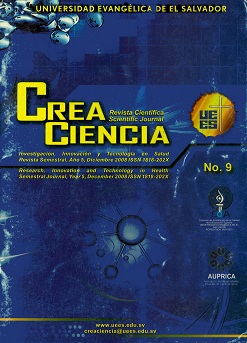Takotsubo cardiomyopathy
DOI:
https://doi.org/10.5377/creaciencia.v0i9.8211Keywords:
takotsubo cardiomyopathy, cardiac syndromeAbstract
Takotsubo cardiomyopathy is a cardiac syndrome recently reported in hp & by Sato (1990), which is characterized by transient left ventricular dysfunction, oppressive precordial pain, electrocardiographic changes of ischemic, discrete or no release of myocardial necrosis markers, simulating an acute myocardial infarction of myocardium (1,2).
This syndrome usually occurs after severe physical or emotional stress, and is predominantly observed in women.
Prior to the report of this syndrome, it had been reported in the world medical literature that, situations that caused great physical stress (major surgeries, serious injuries of the central nervous system) or emotional, were able to produce. Severe in the heart, including acute failure of its systolic function (3, 4, 5, 6, 7, 8, 9, 10, 11, 12, 13).
As the first cases of "takotsubo" were reported in Japan (14, 15, 16), it was initially believed that there could be a genetic component in their cause, related to the eastern ethnic group.
Shortly after the first Japanese series were published, other countries such as Spain, Belgium, Australia and the United States published their first cases (17, 18, 19, 20, 21, 22).
These last reports ruled out that it was a clinical entity related to a particular race.
The Japanese word takotsubo, this composed of tako, which means octopus and tsubo, bottle (1, 2, 6).
This is an artifact designed to catch these mollusks: the animal easily penetrates it but can no longer leave (Fig. 1 and 2).
In Japanese gastronomy, octopus is a very popular meal and takotsubo is frequently used in the homes of Japanese fishermen as an ornament in their interior decoration.
Takotsubo cardiomyopathy has received other names: stress cardiomyopathy (4, 9, 10), broken heart syndrome (7), transient apical transposition of the left ventricle (13,14) and transient apical akinesia syndrome of the left ventricle ( 17, 18, 19).
Some evoke the severe but transitory component of physical or emotional stress in the genesis of the syndrome, determining its relative duration and total clinical recovery in most patients.
Downloads
469
Downloads
Published
How to Cite
Issue
Section
License
© Crea Ciencia
Declaration of originality and assignment of rights
The article must be sent with a declaration of originality, responsibility and assignment of rights of copy of the manuscript, scanned and signed by the author or by one of the authors when the authorship is collective (designated author), stating that the text has not previously published in printed or electronic format, which will not be presented to any other media before knowing the decision of the journal Crea Ciencia and that, if accepted for publication, the authors transfer the copyrights in all forms and media known. At the end of six months of the publication, the text can be shared in another magazine citing the first version of the article published in Crea Ciencia and recording its number and volume. If the article is not published, the UEES agrees to return the rights enunciated to their authors.

Crea Ciencia articles are published in open access and licensed under a Creative Commons Attribution-NonCommercial 4.0 International License.

